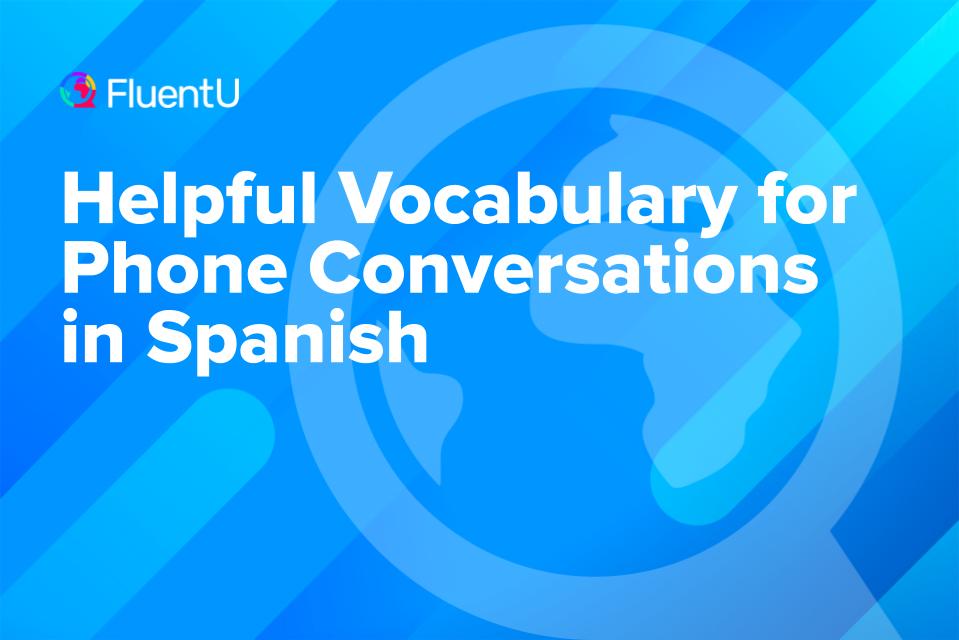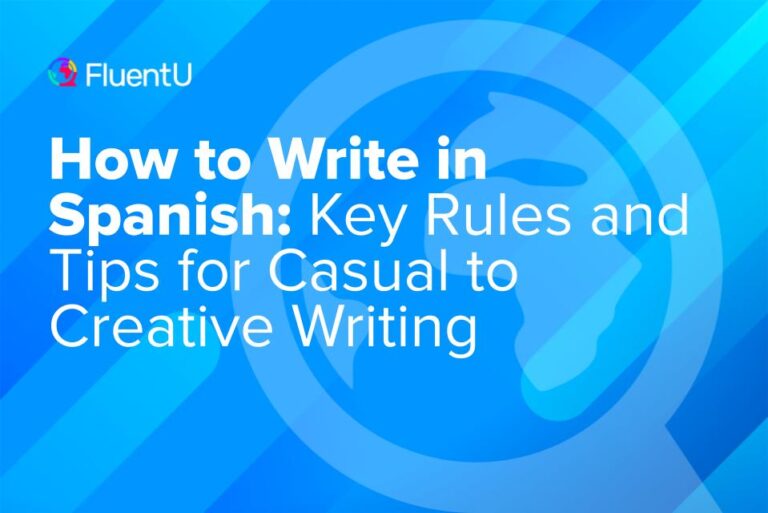Helpful Vocabulary for Phone Conversations in Spanish

While phone conversations are common in any language, many Spanish learners overlook this important skill or assume that general conversation practice will prepare them.
However, there are many phrases that are specific to phone calls that you might not use in general conversation.
That’s why you need to prepare ahead of time. Doing so can give you all the needed words and phrases you need to hold a successful phone conversation.
Dive into this post to learn over 60 words and phrases that will help you with any type of conversation, from business to personal.
Download: This blog post is available as a convenient and portable PDF that you can take anywhere. Click here to get a copy. (Download)
Greetings for Phone Conversations in Spanish
1. ¿Hola?
Hola (“hello”) is a common greeting in person or on the phone. However, on the phone, it’s often inflected as a question rather than a statement. It’s the most common and widely understood Spanish greeting, so it’s a good choice for any phone conversation.
2. ¿Aló?
¿Aló? (hello?) is a common phone greeting used in Latin America. It’s very similar to hola, but is used primarily on the phone rather than in person. It’s also less formal.
3. Buenos días
This means “good day.” It’s used primarily during the daytime, so try to avoid using it during late afternoon or evening hours. For the afternoon, you’d use buenas tardes, and in the evening you’d use buenas noches.
This is a more formal greeting.
For instance, if you call a restaurant to make a reservation, it might play out like this:
Restaurante La Mesa—buenos días. (The Table Restaurant—good day.)
Buenos días. Necesito una reserva. (Good day. I need a reservation.)
4. ¿Bueno?
Bueno usually means “good.” However, in Mexico, it can also be used as a telephone greeting that means the equivalent of “yes?” or “hello?” Internet lore suggests that this emerged in the early 1900s as a way of confirming a telephone had connected, but the exact history is unclear. It can be used formally or informally.
5. Dígame / Diga
Dígame (tell me) or diga (say it) may sound a little aggressive in English, but they’re common telephone greetings in Spanish when you answer a call that you’ve received. They can be used formally or informally.
6. ¿Cómo estás?
¿Cómo estás? is the informal for “how are you?” The more formal option is ¿Cómo está usted? You can use it as an informal way to say “hi,” or save it for a little later in the conversation once you’ve greeted the person and introduced yourself.
7. ¿Podría hablar con…?
¿Podría hablar con…? means “Could I speak with…?” Just fill in the ellipsis (“…”) with the name of the person with whom you want to speak.
8. ¿Podría pasarme a…?
This means “Could you pass me to…?” It’s very much like saying “May I speak with…?”
9. ¿Está…?
Fill in a name in place of the ellipsis (“…”), and you’ve just asked if that person is there.
10. ¿De parte de quién? / ¿De parte?
¿De parte de quién? means “From whom?” However, it’s used like “Who is calling?” ¿De parte? is also used as an abbreviation of this question.
11. ¿Quién habla?
¿Quién habla? is a common Spanish phrase used when answering a phone call to inquire about the identity of the caller. You can use it as a polite way to ask, “Who’s calling?” when you pick up the phone and want to know who is on the line before continuing the conversation. It’s a standard and courteous way to start a phone conversation and identify the caller.
Explanations and Transitions in Spanish Phone Conversations
These phrases will be especially important if you ever need to call to make an appointment in Spanish. Here’s a video with even more words and phrases specific to appointment setting:
12. Llamo para…
This literally means “I’m calling for…” Usually, it’s followed up with a verb to explain why you’re calling. For instance, llamo para hablar con Juan means, “I’m calling to speak to Juan.”
13. Un momento
Un momento is a Spanish phrase that translates to “one moment” in English. It’s used when you need to briefly pause or put the caller on hold during a phone conversation.
You can say un momento, por favor to politely ask the caller to wait for a moment while you attend to something else. It’s a common courtesy in phone etiquette and is used to ensure smooth communication during the call.
14. Número equivocado
Número equivocado means “wrong number.” You can say Lo siento, número equivocado to a caller who has mistakenly called your number right before hanging up.
15. Se ha equivocado de número
This means “You have mistaken the number,” but it’s used like “You have the wrong number.” It uses the formal tense in order to be polite to the caller.
16. ¿Puedo dejar un recado?
¿Puedo dejar un recado? is a polite way to ask if you can leave a message for someone. This phrase is used when you call and want to convey information or a message to the person you’re trying to reach, but they are not available to speak at that moment.
It’s a way of offering to leave a message for them to get back to you later. It can be translated as “May I leave a message?” or “Can I leave a message?” in English.
17. Lo siento, pero no me interesa
This means “sorry, but I’m not interested.” Given the proliferation of scams and sales calls, this is a helpful phrase to learn in as many languages as possible.
Closings for Spanish Phone Conversations
18. Gracias por llamar
Gracias por llamar is a polite way to express gratitude when someone calls you. This phrase translates to “Thank you for calling” in English. It’s used to show appreciation to the caller for taking the time to contact you—thanks for calling!
19. Llámame más tarde
Llámame más tarde translates to “call me later” in English. This phrase is used when you want someone to call you at a later time or when you’re not available to talk immediately. It’s a friendly and straightforward way to request that the person contact you again at a more convenient moment.
20. Volveré a llamar
Volveré a llamar translates to “I will call back” in English. This phrase is used when you want to inform the caller that you will call them again at a later time. It’s a way of letting them know that you intend to continue or resume the conversation later, perhaps when you’re less busy or have more information to share.
21. Me tengo que ir
Me tengo que ir translates to “I have to go” or “I need to leave” in English. This phrase is used to politely indicate that you have to end the conversation or leave the current situation. It’s a courteous way to let the other person know that you need to depart for some reason.
Spanish Phone-related Vocabulary
- Por favor — Please
- Gracias — Thank you
- De nada — You’re welcome
- Permiso — Excuse me / May I?
- Llamada — Call
- Teléfono — Phone
- Contestar — To answer
- Marcar — To dial
- Altavoz — Speakerphone
- Hablar — To talk
- Colgar — To hang up
- Anotar — To write down (For example: Voy a anotar su mensaje. — I will write down your message)
- Tonos de llamada — Ringtone
- Marcador — Dialer
- Conversación — Conversation
- Mensaje de voz — Voicemail
- Transferir — To forward (a phone call)
- Esperar en línea — To hold (as in “Please hold the line.”)
- Llamada perdida — Missed call
- Teléfono celular / Teléfono móvil — Cell phone, mobile phone
- Auriculares — Headset
- Teclado — Keypad
- Comunicación — Communication
- Identificador de llamadas — Caller ID
- Saludo — Greeting
- Desconectar — Disconnect
- Red móvil — Mobile network
- Recibir — To receive (as in “receive a call”)
- Realizar una llamada — To make a call
- Devolver una llamada — To call back
- Conferencia telefónica — Conference call
- Sonar — To ring
- Agenda de contactos — Contact list
- Línea ocupada — Busy line
- Reproducir mensajes de voz — To play voicemail
- Tarjeta SIM — SIM card
- Plan de datos — Data plan
- Cobertura — Coverage
- Número de teléfono — Phone number
- Línea fija — Landline
- Mensaje de texto — Text message (SMS)
- Vibrar — To vibrate
- Operadora — Operator
- Poner en modo avión — To put in airplane mode
Example Spanish Phone Conversation
Marta: Hola, buenas tardes. Me gustaría hacer una reserva para cenar esta noche, por favor. (Hello, good afternoon. I would like to make a dinner reservation for tonight, please.)
Café El Portal: ¡Hola! Claro, estaríamos encantados de recibirla. ¿A qué hora le gustaría hacer la reserva? (Hi! Of course, we’d be happy to have you. What time would you like to make the reservation?)
Marta: ¿Tienen disponibilidad a las 8:00 PM? (Do you have availability at 8:00 P.M.?)
Café El Portal: Sí, tenemos una mesa disponible a las 8:00 PM. ¿Para cuántas personas será la reserva? (Yes, we have a table available at 8:00 P.M.. How many people will be in your party?)
Marta: Seremos cuatro personas en total. ¿Puedo reservar a nombre de Marta, por favor? (There will be four of us in total. Can I make the reservation under the name Marta, please?)
Café El Portal: Por supuesto, Marta. Su reserva para cuatro personas a las 8:00 está confirmada. ¿Algún requerimiento especial o alergias alimentarias que debamos tener en cuenta? (Of course, Marta. Your reservation for four people at 8:00 PM is confirmed. Any special requests or dietary allergies we should be aware of?)
Marta: Nada en particular, gracias. Estamos emocionados por cenar en Café El Portal esta noche. (Nothing in particular, thank you. We’re looking forward to dining at Café El Portal tonight.)
Café El Portal: Estaremos encantados de tenerla aquí, Marta. La esperamos a las 8:00. ¡Hasta luego! (We’re delighted to have you, Marta. We’ll see you at 8:00 P.M. Goodbye!)
Marta: ¡Hasta luego y gracias! (Goodbye and thank you!)
How to Practice for a Spanish Phone Conversation
Now that you know all these phrases, how can you practice them and prepare for the real thing? Here’s some methods on how you can do so.
- Test out your phone skills with a Spanish-speaking friend
You don’t even need to talk about anything in particular—just run through basic polite phrases to ensure you have them down. Whether you play through a standard phone conversation online, in person or using actual phones, testing your skills will help you see areas of weakness and also give you the boost you need to prepare you for higher pressure phone calls.
- Develop your vocabulary
One thing you don’t want to do during a phone call is find yourself fumbling for words while there’s a long awkward silence. A good way to avoid this is to create a daily practice to broaden your vocabulary, and instead of learning words in isolation, you should aim to learn the words in proper context so you know how to use them. For the words you learn, you could create your own vocabulary list, flashcards and quizzes. You can also use the language learning program FluentU to learn Spanish vocabulary in context.
FluentU takes authentic videos—like music videos, movie trailers, news and inspiring talks—and turns them into personalized language learning lessons.
You can try FluentU for free for 2 weeks. Check out the website or download the iOS app or Android app.
P.S. Click here to take advantage of our current sale! (Expires at the end of this month)

- Hold a conversation with yourself
Sure, talking to yourself can be awkward, but you can easily run through a standard phone call. This will help give you more confidence in speaking.
- Connect with native speakers
Fun, friendly online exchanges are great for practicing phone conversations. There are some helpful online resources like Conversation Exchange that can connect you with native speakers for this purpose.
- Practice with dialogues and other resources
Using sample conversations as guidance can help you along. Video or audio dialogues are particularly useful in showing you how a Spanish-language phone call might play out.
YouTube is a good source for telephone dialogues and similar tools. For instance, Calico Spanish Songs for Kids offers a song about answering the telephone. LCF Clubs also has a song on telephone conversations that teaches common vocabulary and phrases you might use on phone.
For a dialogue, you might try 123dialogues, which offers a useful mock telephone conversation.
With these words and phrases under your belt, you’ll never have to put a Spanish phone conversation on hold!
Download: This blog post is available as a convenient and portable PDF that you can take anywhere. Click here to get a copy. (Download)
And One More Thing…
If you've made it this far that means you probably enjoy learning Spanish with engaging material and will then love FluentU.
Other sites use scripted content. FluentU uses a natural approach that helps you ease into the Spanish language and culture over time. You’ll learn Spanish as it’s actually spoken by real people.
FluentU has a wide variety of videos, as you can see here:

FluentU brings native videos within reach with interactive transcripts. You can tap on any word to look it up instantly. Every definition has examples that have been written to help you understand how the word is used. If you see an interesting word you don’t know, you can add it to a vocab list.

Review a complete interactive transcript under the Dialogue tab, and find words and phrases listed under Vocab.

Learn all the vocabulary in any video with FluentU’s robust learning engine. Swipe left or right to see more examples of the word you’re on.

The best part is that FluentU keeps track of the vocabulary that you’re learning, and gives you extra practice with difficult words. It'll even remind you when it’s time to review what you’ve learned. Every learner has a truly personalized experience, even if they’re learning with the same video.
Start using the FluentU website on your computer or tablet or, better yet, download the FluentU app from the iTunes or Google Play store. Click here to take advantage of our current sale! (Expires at the end of this month.)








